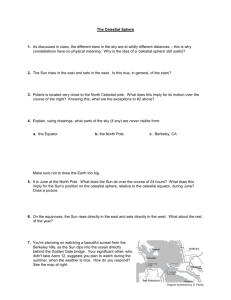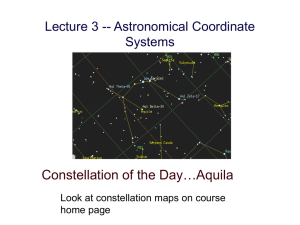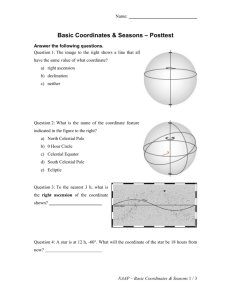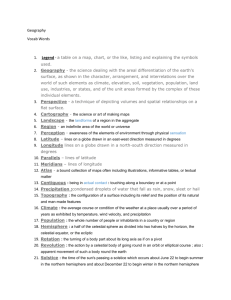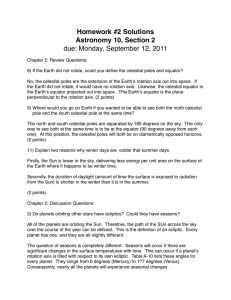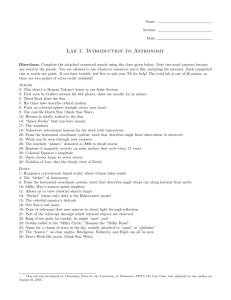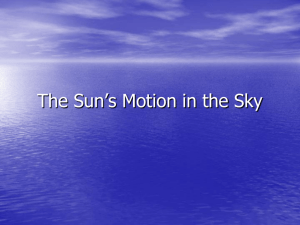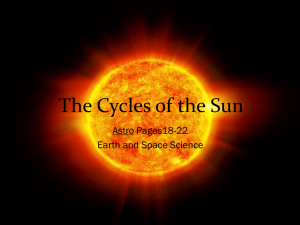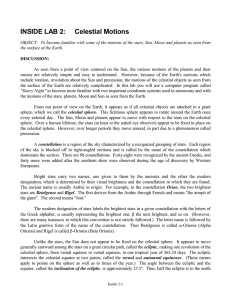03jan15.ppt
advertisement
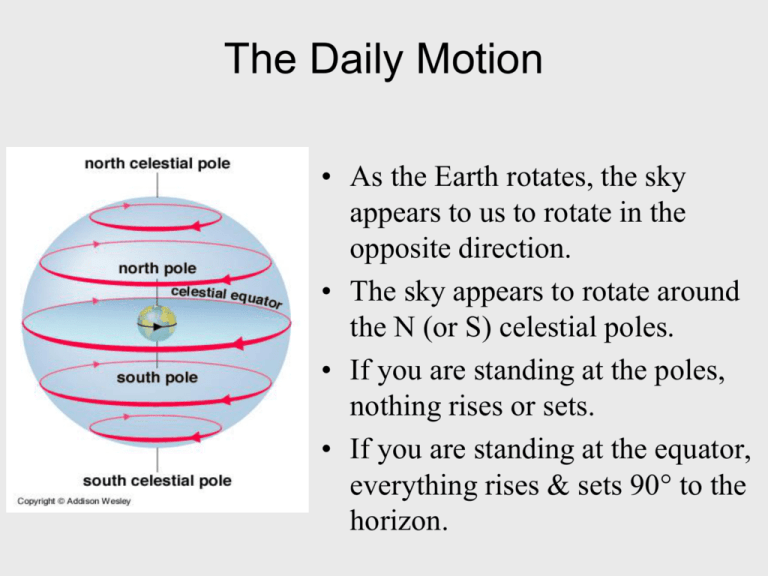
The Daily Motion • As the Earth rotates, the sky appears to us to rotate in the opposite direction. • The sky appears to rotate around the N (or S) celestial poles. • If you are standing at the poles, nothing rises or sets. • If you are standing at the equator, everything rises & sets 90 to the horizon. The Daily Motion • The altitude of the celestial pole = [your latitude]. • All stars at an angle < [your latitude] away from: – your celestial pole never set. (circumpolar) – the other celestial pole are never seen by you. • Other stars, (& Sun, Moon, planets) rise in East and set in West at an angle = [90 your latitude]. The Daily Motion daily circles --- CCW looking north, CW looking south Höküpaÿa Newa Time Exposure Photograph: • Estimate the exposure time • Which direction did stars move? Annual Motion • As the Earth orbits the Sun, the Sun appears to move eastward with respect to the stars. • The Sun circles the celestial sphere once every year. Annual Motion ecliptic the apparent path of the Sun through the sky equinox where the ecliptic intersects the celestial equator solstice where the ecliptic is farthest from the celestial equator zodiac the constellations which lie along the ecliptic Annual Motion • The Earth’s axis is tilted 23.5° from being perpendicular to the ecliptic plane. • Therefore, the celestial equator is tilted 23.5° to the ecliptic. • As seen from Earth, the Sun spends 6 months north of the celestial equator and 6 months south of the celestial equator. The Cause of the Seasons Summer Winter • Seasons are caused by the Earth’s axis tilt, not the distance from the Earth to the Sun! The Cause of the Seasons Axis tilt changes directness of sunlight during the year. Why Does Flux Sunlight Vary Seasonal Change in Sun’s Altitude • The “Figure 8” shows Sun at same time each day over a year. When is summer? • The solstice which occurs around June 21 is considered the first day of summer. • It takes time for the more direct sunlight to heat up the land and water. • Therefore, July & August are typically hotter than June. Why doesn’t orbital distance from the Sun matter? • Small variation for Earth — about 3% (but orbit distance does matter for some other planets, notably Mars and Pluto). • Surprisingly, seasons are more extreme in N. hemisphere, even though Earth is closer to Sun in S. hemisphere summer (and farther in S. hemisphere winter) — because of land/ocean distribution What is 55.435 degrees in degreesminutes-seconds notation? 55 deg 0.435(60) 26.1arcmin 26 arcmin 0.1(60) 6arcsec so, 55o 26'06" What is decimal 73o 45in33 . 56 degrees? 73 deg 45/60 .75 33.56/3600 0.009322 73.759322 Homework #2 • 45.635 degrees is how many degrees, arcminutes, and arcseconds? • How many degrees, arcminutes, and arcseconds does the moon move across the sky in one hour? (the lunar day is 24 hours and 48 minutes long) • The moons diameter is about 30 arcminutes, so find out how long it takes for the moon to travel its diameter. Precession of the Equinoxes • The Earth’s axis precesses (wobbles) like a top, once about every 26,000 years. • Precession changes the positions in the sky of the celestial poles and the equinoxes. Polaris won't always be the north star. The spring equinox, seen by ancient Greeks in Aries, moves westward and is now in Pisces!
